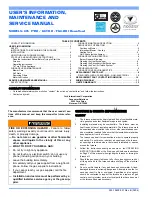
18
WARNING:
THE FURNACE IS EQUIPPED TO RUN ON
NATURAL GAS ONLY. AN LP/PROPANE
CONVERSION KIT IS NOT AVAILABLE. USE
OF LP/PROPANE WITH THIS FURNACE CAN
CAUSE FIRE, EXPLOSION, PROPERTY DAMAGE,
CARBON MONOXIDE POISONING, PERSONAL
INJURY, OR DEATH.
This furnace is equipped and rated to operate up to 2,000 ft.
only. There are no conversion kits or ratings above 2,000 ft.
NOTE:
The main burner orifice is located inside the brass
orifice fitting attached to the combustion air inlet venturi.
lists gas flow capacities for standard
pipe sizes as a function of length in typical applications based
on nominal pressure drop in the line.
The furnace may be installed with either left or right side gas
entry. When connecting the gas supply, provide clearance
between the gas supply line and the entry hole in the furnace
casing to avoid unwanted noise and/or damage to the furnace.
Typical gas hookups are shown in
Figure 18. Typical Gas Connections for Upflow Models
Gas Valve
See Note “B”
Right Side Entry
Left Side Entry
See
Note “A”
Shut-Off
Valve
Ground
Joint
Union
Drip Leg
Gas Burner Head
Drip Leg
Shut-Off
Valve
Plug
Ground
Joint
Union
NOTE A: Consult local codes for Shut-Off Valve location requirements
NOTE B: Inducer assembly omitted for clarity of pipe installation
Gas
Valve
See Note “B”
See
Note “A”
Plug
Flexible
Gas Line
Flexible
Gas Line
FURNACE
INPUT
MAIN BURNER
ORIFICE SIZE
MAIN AIR
ORIFICE DIAMETER
MANIFOLD
PRESSURE
50,000
#30
1.050”
3.5
100,000
#16
1.380”
3.5
Table 4. Vent & Inducer Blower Options
Leak Check
WARNING:
FIRE OR EXPLOSION HAZARD
Failure to follow safety warnings exactly could
result in serious injury, death or property
damage.
Never test for gas leaks with an open flame.
Use a commercially available soap solution
made specifically for the detection of leaks
to check all connections. A fire or explosion
may result causing property damage, personal
injury or loss of life.
After the gas piping to the furnace is complete, all connections
must be tested for gas leaks. This includes pipe connections
at the main gas valve, emergency shutoff valve and flexible
gas connectors (if applicable). The soap and water solution
can be applied on each joint or union using a small paintbrush.
If any bubbling is observed, the connection is not sealed
adequately and must be retightened. Repeat the tightening
and soap check process until bubbling ceases.
IMPORTANT NOTE:
When pressure testing gas supply lines at pressures
greater than 1/2 psig (14 inch W.C.), the gas supply
piping system must be disconnected from the furnace
to prevent damage to the gas control valve. If the test
pressure is less than or equal to 1/2 psig (14 inch W.C.),
close the manual shut-off valve.
















































